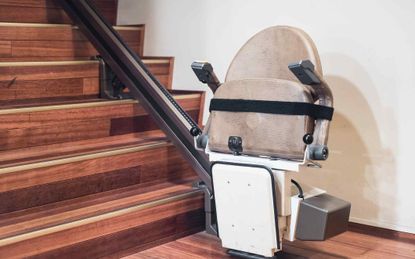Moves to Make Now To Age in Place
If you are a longtime homeowner and thinking ahead to your next stage of life, you’re probably familiar with the idea of aging in place.

If you are a longtime homeowner and thinking ahead to your next stage of life, you’re probably familiar with the idea of aging in place. You might already be considering renovation projects, such as installing grab bars in your bathroom or widening your doorways, to help you stay put. You’re not alone in your pursuit: About 76% of Americans age 50 and older say they want to stay in their homes, and 77% hope to remain in their neighborhoods as long as possible, recent AARP research shows.
But renovations are just a part of what you need to make aging in place work for you. While it’s typically less expensive to remain in your home than to pay for assisted living, that doesn’t mean it’s a slam dunk to stay put. You’ll still have a long to-do list. Just one example: You need to plan ahead for how you will manage maintenance and care—for your home, and for yourself, as you age and face health challenges.
And be aware that strengthening your social fabric now might be just as important as shoring up your finances and installing a curbless shower. Building a network of support among friends and neighbors, and establishing strong ties in your community, from volunteering to just enjoying casual conversations at the local coffee shop, play important roles in keeping older adults healthy and functioning, experts say. You won’t age in place well if you’re isolated and alone, a reality you don’t want to overlook as you consider your housing and financial options.
“The social connections you have and the access to services in your community are often more important than anything else,” says Jessica Finlay, a University of Michigan researcher who studies older adults and their neighborhoods (learn more about her researchat jessicafinlay.com). “You need a reason to get out of bed in the morning and to get out the front door.”
Aging in place also can be more challenging than you might expect. While most seniors say they want to age in place, a much smaller percentage of them actually manage to accomplish it, studies show. Transportation is often a problem; when you can no longer drive, you can’t get to medical appointments or to other outings. Long-term-care costs, even when you stay at home, outpace savings. Older homes can be costly to maintain and downsizing to a smaller one closer to a city center may be more expensive than you thought.
The worst-case scenario is finding yourself “stuck in place,” as Freddie Mac chief economist Sam Khater puts it. You’re still in your home, but you aren’t able to age well because you can’t afford to make needed improvements and you’re increasingly isolated.
But the good news is that you can start now to make aging in place successful, even if you are still a few years away from a final decision. Even getting the idea on your radar allows you time to save up for individual renovation projects, such as a ramp, and to make an overall plan. It’s not easy to think about how you’re going to age and what life will be like when your mobility is limited, but forcing yourself to begin preparing now will pay off later.
That’s the approach Wendy Zenker, 66, a retiree in Arlington, Va., took when she considered renovations five years ago to her large, two-story brick home. She’s healthy and active, but she broadened her initial plans for just adding a porch in the back to creating a one-floor living space for when she needs it eventually.
“I wasn’t initially thinking about aging in place, but I started to worry about what would happen if I fell down and broke a leg or something,” she says. “I know everyone on my block, and it’s important for me to stay here, with this network of friends and neighbors. So I decided to figure out how to prepare for that.”
The definition of aging in place is flexible and still evolving, as more older Americans find new kinds of arrangements to stay in their homes. It often means one-floor living. Or it might mean sharing your home, if the rent will help you afford to keep it. Or you might sell your longtime home and move into a smaller one, closer to amenities, where you plan to grow old—your “forever home.”
Regardless of which arrangement fits you, use these five moves now to help you age in place successfully. If there’s truly no place like home for you, there are ways to make it work.

Move #1: Start Early
If you wait until you have a fall or an illness to make modifications to your home, it may be more costly and a bigger hassle than if you begin planning well in advance, says Meredith Stoddard, head of the Life Events team at Fidelity Investments. But before thinking about construction projects, make sure aging in place really is the right fit for you.
“Being self-aware is the first step,” she says. Are you really willing to make social connections, such as showing up regularly at the senior center or volunteering? Was your spouse or partner the one who initiated all your social connections? If so, avoiding being isolated “is not going to magically happen,” particularly if you live in a rural area with fewer interactions with neighbors and less walkability, she says.
Decide if you are ready to be proactive and if you can handle aging in place as opposed to living in a senior housing community, which might have many planned or scheduled activities. “You have to take accountability for your own happiness and well being,” she says.
Make sure you are as fit and healthy as possible to increase the likelihood you’ll be successful staying at home, says Marie Bernard, MD, deputy director of the National Institute on Aging. Strength and balance training can help you stave off falls and exercising regularly may help your cognitive function. Work closely with your primary care provider, and start an exercise program now. “If there’s anything that’s a fountain of youth, exercise may be it,” she says.
Review your surrounding community to make sure it will have the amenities that you need. Just being able to go to a coffee shop and listen to the hum of conversations around you can help you feel less lonely, Finlay says. Figure out if there are medical facilities, grocery stores and places to socialize that are easy to access and enough walkable options to make it worth staying. Keep in mind the four “s” factors—safety, services, social connections and stimulation—and investigate whether they exist in your community.
Zenker says her neighbors shovel each other’s sidewalks, look out for young children playing in the neighborhood, throw block parties and celebrations, and warmly greet newcomers. She’s lived the longest on her block, and it feels like her permanent home. “I can’t imagine not having this community around me,” she says.
Also, begin to think about your finances. If you’re married, make sure you and your partner are on the same page—you should both know how to track and pay bills. Open up your finances to an adult child or a trusted relative or professional for help in reviewing your accounts, and sign up for credit-monitoring services. You want to lay the groundwork for bigger financial decisions you’ll make in the coming years (see Move No. 3), especially before you face possible cognitive problems, Stoddard says.

Move #2: Go Slow
It might seem intimidating to look around a large house with multiple bedrooms, stairs and levels, and wonder how you can ever make it age friendly. But you don’t have to do everything at once. Tackle projects in increments and you can gradually create a safe and livable space, says Sarah Susanka, an architect and author of The Not So Big House series (Taunton Press, $21). “No matter what your income bracket, you have a lot more options than you may realize,” she says. “You can take almost any house, and with a little bit of modifications, make it work.”
Transform a main level screened porch or office into a future bedroom, and remodel a powder room into a full bath, and you’ve got one-floor living space, for example. Retain your remaining upstairs bedrooms to eventually house full-time, live-in caregivers, which is something many older adults fail to consider in their plans, Susanka says.
Simple things such as taping down throw rugs won’t cost you much, and other improvements don’t have to break your budget. Widening a doorway typically runs about $600 to $1,000. For her parents’ house, Susanka bought two $99 ramps on Amazon to install at two separate sets of small steps within the home, and she bought a $150 ramp to allow access for a wheelchair from the inside to the backyard terrace. “It’s all they needed for now,” she says.
If you feel overwhelmed, schedule a meeting with an architect familiar with aging in place. Susanka says there are many architects who will make a house call for just an hourly consultation fee for ideas on improvements. (She’s compiled a searchable list at susanka.com.)
But don’t wait too long to start, so that you can still have a say in your renovation preferences. Susanka says she learned this from experience; her father, an engineer in his nineties, can no longer draw any of his remodeling ideas, although he knows exactly what he wants.
Stephen Grant, 78, a retired Foreign Service officer in Arlington, Va., began to worry about his future because he has foot neuropathy, which he expects will limit his mobility as he ages. But he wants to remain in his longtime Dutch Colonial home.
After meeting with a local aging-in-place specialist, Grant had a wheelchair-accessible external ramp built on two sides of his house, next to his driveway, kitchen and garage, about three years ago. For now, his adult children and their kids use it to roll up their suitcases during holiday visits. But Grant says he believes it will be useful to him someday. “I built it well in advance of when I’ll need it, but for me it’s peace of mind,” he says.

Move #3: Figure Out Your Finances
If you’ve lived in your home for many years, your equity may be your most available source of financing. Homeowners age 62 and older have high home ownership levels and are sitting on record levels of home equity—as much as $6.6 trillion by some estimates. But you’ll need to think hard about the trade-offs involved in using it, Khater says.
You could take out a home equity line of credit (Heloc) or a reverse mortgage to pay for renovations or in-home care. Avoid using your credit card for any financing, because interest rates will usually be much higher than your other options. However, tapping your equity means giving up something in return, particularly if you intend on giving your home to your children or other heirs after you die. “It can be a bit dicey,” Khater says. “You’ll be passing on less than you expected.”
There are other costs. You still owe property taxes and insurance with a reverse mortgage, and the interest rates on a Heloc generally are adjustable and could go up. Consider some alternatives, Khater says. If you have adult children, work out an arrangement in which they help you pay for renovations now and you remunerate them with your home after your death, he says. Or, if you don’t want to be a burden to your children, use the equity now to pay for your care and home maintenance. All this entails having a difficult family conversation sooner, rather than later.
Check with a mortgage professional and see if it makes sense for you to refinance. Consider tapping into a Roth account, says Mike Lynch, Charlotte-based managing director at Hartford Funds. And model different scenarios, such as a combination of home equity and other funds, to see what financial arrangement would work out the best.
Your simplest strategy may be to include projected renovation costs in your overall retirement budget, says Mark Stinson, a senior advisor who specializes in retirement at FAI Wealth Advisors, in Columbia, Md. Count your aging-in-place renovations as a one-time expense you’re going to have every few years, in addition to regular maintenance, so it’s worked into your budget and doesn’t come as a surprise. “Planning and saving is really the best way to go,” he says.
Finally, accept that you’re not likely to get a return on your investment. New buyers may not want the changes you made, and your real estate agent likely won’t approve. Remember that you’re renovating for your own reasons, not as an investment, Khater says. “You’ll be much happier because you’re retrofitting” to stay in your house, than if you expect a possible financial gain when you sell.

Move #4: Choose Your Forever Home
If your house is just too big for you and too expensive to renovate, or your neighborhood is too sprawling and isolated, you might consider downsizing to a townhome or a smaller home near a town center. But you may be surprised to find it’s more costly than you expected. Thinking you’ll save money by downsizing is one of the biggest retirement fallacies and that’s especially true for seniors looking for their forever homes. You’ll find yourself competing for a limited housing stock with a younger generation of buyers looking for starter homes. “It’s more and more expensive to downsize,” Khater says. “The lack of supply is driving up the prices of homes.”
But if you can swing it, finding that forever home can be a way to age well, in a supportive community. That’s how it worked for Lynch, 56, who traded in a large family home in the suburbs of Charlotte two years ago for a smaller, one-floor townhouse near downtown. Lynch’s children were grown and the house felt too big for just him and his wife, and the couple had fewer connections with their neighbors with their kids gone. In their new townhouse, they can walk to the drycleaner and the local Starbucks. “We have a lot of flexibility to get out and do the things we want to do,” he says. “It used to take us half an hour to drive to the supermarket.” Lynch says he had some “sticker shock” at the prices of smaller homes closer to the city, so he chose one just on the outskirts, at a lower cost.
In Minnesota, even the harsh winters didn’t stop Lou and Allan Burdick from finding a forever home in downtown Minneapolis. The couple decided against retiring in Arizona or Florida, as many of their friends did, and instead swapped their 4,800-square-foot home in Edina, an upscale suburb, for a condo half that size.
Allan, 82, says it “took a while to get used to the idea” of living in smaller quarters, but the couple has been in the condo for more than 10 years and plans to remain as long as they can. They were founding members of Mill City Commons—a neighborhood “village” with programs and services for older adults living in the central riverfront district. Making those connections was part of the motivation for the Burdicks to age in place in a city condo. There are coffees, conversation groups, theater outings and dinner gatherings. When Lou had major surgery, she could recover at home; neighbors brought meals and offered rides.
That kind of support is particularly important to a fellow Mill City resident, Nancy Reed, a retiree in her early seventies. Her husband died about five years ago, and she recently sold their large townhome and moved into a smaller downtown condo. “I saw it as a close-knit community, and I wanted to simplify my life, and make it easier for my family, in case something did happen to me,” she says. She takes part in yoga, a walking club, a book group, and many social and volunteer activities. “It’s my forever home,” she says. “It’s really a nice community, and I don’t feel isolated here.”

Move #5: Create an Alternative Income Stream
If you can’t swing a forever home and you still want to stay where you are, you need an alternative source of income. And an increasingly popular one among seniors is home sharing. Silvernest, a home-sharing service for older homeowners that matches them with roommates, started just five years ago and already gets eight applications for every listing, says founder Wendi Burkhardt. Older homeowners, she estimates, can make $12,000 to $18,000 annually renting a room out.
Ralph Patrick, 58, of Longmont, Colo., took in a housemate about three years ago, after the last of his four kids moved out. “I just didn’t like living by myself,” he says. “I really experienced the empty-nest syndrome in a big way.”
When Patrick decided to end the arrangement, his housemate—a man in his fifties—was disappointed, but the two only had an informal agreement. In retrospect, Patrick says he learned you need to have clear boundaries to share your home. With his new, second housemate, Patrick drew up a formal lease arrangement.
His current housemate is a woman in her sixties. It’s nice to sometimes have company and not come home to an empty house, he says. And the extra income comes in handy. You can use Silvernest if you are more comfortable with an agency, instead of Craigslist or other roommate advertising sites. Silvernest handles background checks and other services. Or look for home-sharing programs in your community.
Bren Atchison, 68, of Roxbury, Mass., decided on home sharing after her costs were piling up for her home, which had been in her family for generations. She signed up with a local program that matches university students in the area looking for affordable housing with older homeowners. Atchison has had housemates from MIT students to young musicians, and she loves the intergenerational aspect of it. One former housemate baked her cookies and took her to a concert. “I’m driven by my love for my home, and I have a lot of roots here,” she says. Taking in housemates is “not as scary and as challenging as you think it might be. I realized I had all these extra rooms, and they were just collecting dust. I just wish I’d done it earlier. It’s definitely helped me financially.”
- If home sharing isn’t for you, consider a growing number of other alternative arrangements, such as an accessory dwelling unit. More communities are relaxing zoning laws to allow for homeowners to build a second, small dwelling on their properties, such as a tiny house in the backyard. You can bring in extra income or house a family member. Whether you go that route or take a more traditional path, with some planning and effort, you can find or create a forever home for your final years.
Get Kiplinger Today newsletter — free
Profit and prosper with the best of Kiplinger's advice on investing, taxes, retirement, personal finance and much more. Delivered daily. Enter your email in the box and click Sign Me Up.

-
 RMD Deadline April 1: Five Tax Strategies to Manage Your 2025 Income
RMD Deadline April 1: Five Tax Strategies to Manage Your 2025 IncomeTaxable Income The April 1, 2025, deadline for required minimum distributions (RMDs) is fast approaching for retirees who turned 73 in 2024.
By Kelley R. Taylor Published
-
 Rising AI Demand Stokes Undersea Investments
Rising AI Demand Stokes Undersea InvestmentsThe Kiplinger Letter As demand soars for AI, there’s a need to transport huge amounts of data across oceans. Tech giants have big plans for new submarine cables, including the longest ever.
By John Miley Published
-
 What Does Medicare Not Cover? Eight Things You Should Know
What Does Medicare Not Cover? Eight Things You Should KnowHealthy Living on a Budget Medicare Part A and Part B leave gaps in your healthcare coverage. But Medicare Advantage has problems, too.
By Donna LeValley Published
-
 12 Great Places to Retire in the Midwest
12 Great Places to Retire in the MidwestPlaces to live Here are our retirement picks in the 12 midwestern states.
By Stacy Rapacon Published
-
 10 Cheapest Small Towns to Live In
10 Cheapest Small Towns to Live InThe cheapest small towns might not be for everyone, but their charms can make them the best places to live for plenty of folks.
By Dan Burrows Published
-
 Best Cold Weather Places to Retire
Best Cold Weather Places to RetirePlaces to live Some like it hot; others not so much. Here are the 12 best places to retire if you can't stand the heat.
By Stacy Rapacon Published
-
 15 Reasons You'll Regret an RV in Retirement
15 Reasons You'll Regret an RV in RetirementMaking Your Money Last Here's why you might regret an RV in retirement. RV-savvy retirees talk about the downsides of spending retirement in a motorhome, travel trailer, fifth wheel or other recreational vehicle.
By Bob Niedt Published
-
 The Cheapest Places To Retire in the US
The Cheapest Places To Retire in the USWhen you're trying to balance a fixed income with an enjoyable retirement, cost of living is a crucial factor to consider.
By Stacy Rapacon Published
-
 The Six Best Places to Retire in New England
The Six Best Places to Retire in New Englandplaces to live Thinking about a move to New England for retirement? Here are the best places to land for quality of life, affordability and other criteria.
By Stacy Rapacon Last updated
-
 13 Smart Estate Planning Moves
13 Smart Estate Planning Movesretirement Follow this estate planning checklist for you (and your heirs) to hold on to more of your hard-earned money.
By Janet Kidd Stewart Last updated

